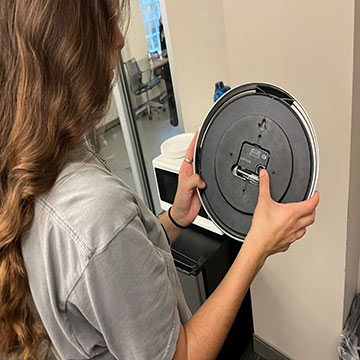The sun now sets around 5:45 p.m. (Photo by Katie Rojas/Carolina News & Reporter)
Emma Shuster, a junior mass communications student, enjoys walking along Columbia’s Riverwalk after class to view the sunset.
She walks to her car at about 5:30 p.m. The sun is beginning to set. Now, she feels limited as to what she can do.
For many students, the fall-back time change affects their daily routines, mental health and sense of security.
“I definitely get a bit seasonally depressed,” Shuster said. “I would definitely say it impacts my routine.”
The early darkness disrupts her evening activities.
“I’m not going to lie, it is extremely difficult to get out and then have your day be over at 6 p.m.,” Shuster said. “It just feels very weird. And you just have to get used to it, because it’s almost like you go home and you want to get in bed. But you still have time and still have things to do. It’s like it almost puts your body in that (state of confusion).”
Erin Andrews is director of clinical affairs for Uwill, the online mental health advising site. She said reduced sunlight exposure is linked to seasonal affective disorder or SAD – a type of depressive disorder that occurs when there’s less sunlight in fall and winter.
SAD disrupts circadian rhythms and can lead to fatigue throughout the day. It also decreases serotonin levels.
Symptoms include social withdrawal, lack of motivation, sleep disturbances and sadness, Andrews said.
“There’s not a ton of research specifically on college students when it comes to SAD,” she said. “The assumption is that it just mirrors the typical population, with 5 to 10% of people experiencing some symptoms in a given year.”
But there’s speculation that college students are more vulnerable because of the increased amount of stress they’re experiencing at this point in their lives, Andrews said.
“There’s a lot of academic stress, a lot of different responsibilities that they’re juggling, they’re away from their family unit, which is reducing their access to social support and things that are often keeping them established in their routines,” Andrews said. These factors can “impact students more severely than other people.”
Shuster prefers to do her homework outside, but that option is limited during certain hours. She said those who want to do certain activities in the daylight need to plan ahead.
There is also a safety concern with evening activities during the winter months.
“I like to go to the river, but I’m a girl,” Shuster said. “I’m not going to do that once it gets dark. I’ve done that once or twice before, and the sun started setting. So I got freaked out and ran all the way back to my car.”
Some students prefer the fall-back time change instead of spring-forward.
“I like it more because I get an extra hour of sleep,” said Vivienne Trifiletti, a freshman nursing student.
Trifiletti said the earlier sunsets motivate her to be more productive during the day. She also is able to wake up earlier with the early sunrises instead of sleeping in “until 11 a.m.”
It’s definitely not as common for people to be affected by spring-forward, but everybody reacts differently, Andrews said.
“There are some people that do not feel as inclined to the sun, and there are others that really feel like they need it,” she said.
Many people tend to feel worse when the clocks fall back, but feel better when it springs forward, Andrews said.
“There are people who are having the opposite of that experience where they like the cold weather and darkness because it makes them feel cozy and more rested,” she said. “It just depends on each individual and what their preferences and needs are.”
Andrews said there are options for students to manage seasonal symptoms during the darker months.
Light therapy mimics sunlight and helps improve mood and sleep patterns. Lifestyle changes such as sticking to a sleep schedule, exercising, eating well and spending time in natural daylight can also make a difference, though those can be tricky with a busy schedule.
Another option is cognitive behavioral therapy, which can help shift negative thoughts into positive ones and encourage healthier habits.
In the past six years, 20 states, including South Carolina, have passed laws or resolutions to make daylight saving time (spring-forward) permanent. But federal law only allows states to stay on standard time (fall-back) year-round—not daylight saving time.
The change can only happen if Congress approves it.
Arizona and Hawaii are the only two U.S. states that don’t observe daylight saving time at all.
This spring, daylight saving begins March 9, 2025, and there are no plans for the U.S to stop the yearly clock changes.
Arizona and Hawaii are the only U.S. states that don’t observe daylight saving time. (U.S. Bureau of Transportation Statistics/Katie Rojas/Carolina News & Reporter)
An overview of countries and territories with DST in 2024. Countries, states and territories sometimes announce changes just days or weeks before the time change. (Time and Date/Katie Rojas/Carolina News & Reporter)
Students changed clocks back one hour on Nov. 3. (Photo by Katie Rojas/Carolina News & Reporter)





